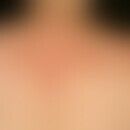Synonym(s)
HistoryThis section has been translated automatically.
Goltz and Laymon, 1954
DefinitionThis section has been translated automatically.
You might also be interested in
EtiopathogenesisThis section has been translated automatically.
Unknown. Associations with malignant tumors such as colon carcinomas, breast carcinomas, cervical carcinomas exist in about 28% of cases. Occurring in hypothyroidism, also after injection of X-ray contrast agents. Association with tuberculosis has been observed.
ManifestationThis section has been translated automatically.
LocalizationThis section has been translated automatically.
ClinicThis section has been translated automatically.
Skin lesions: Symmetrically distributed, multiple, pinhead- to pea-sized, mostly dermal-consistent, skin-colored but also copper-brown, sometimes slowly growing, sometimes eruptively exanthematous, solitary, also confluent papules and nodules, possibly with atrophic, possibly also excoriated, mostly smooth surface. Typical (>50% of cases) is a pearl-like involvement of the nail folds of the fingers (coral bead sign). Itching is not infrequently reported. Xanthelasma is present simultaneously in 25% of cases.
Arthropathies: swelling, painful immobilization, mutilating arthritis of the primary chronic polyarthritis type (rheumatoid arthritis), especially of the fingers and metacarpals, also of the vertebral joints and sacroiliac joints.
HistologyThis section has been translated automatically.
In early lesions, cellular inflammatory responses of histiocytes and lymphocytes are seen in the upper and middle dermis. In older lesions, the typical substrate consists of large mononuclear and multinuclear giant cells (see Fig.). PAS-reactive, diastase-resistant, and lipid-soluble substances are present in the cytoplasm.
In the final stage, there is fibrosis.
Granulomatous tissue reactions with accumulations of large, MS-I (high molecular weight protein) positive histiocytes, cytoplasm-rich macrophages, and giant cells with PAS-reactive, lipid-soluble substances are present. Stabilin-1: positive, S100 and CD1a: negative.
Differential diagnosisThis section has been translated automatically.
TherapyThis section has been translated automatically.
External therapyThis section has been translated automatically.
Internal therapyThis section has been translated automatically.
Symptomatic antirheumatic treatment with non-steroidal anti-inflammatory drugs such as diclofenac (e.g. Voltaren) 2 times 50 mg/day. The disease is self-limited in most cases (healing after an average of 8 years).
A few severe courses have been described with severe manifestation of skin symptoms, persistence of the clinical picture and organ involvement. In these cases, immunosuppressive therapy may be necessary. Try glucocorticoids initially 100 mg prednisolone equivalent/day (e.g. Decortin H), slowly tapering off.
Approaches with cytostatics (cyclophosphamide 50 mg/day p.o. or methotrexate up to 25 mg/week i.m. or i.v.) have been described in isolated cases with moderate success. When using cytostatics, a strict indication is necessary, since aggravations of the clinical picture are possible.
Operative therapieThis section has been translated automatically.
Progression/forecastThis section has been translated automatically.
Case report(s)This section has been translated automatically.
- Histology: dermal infiltrate with large polygonal cells characterized by an eosinophilic milky glassy cytoplasm and large clumsy nuclei. These cells expressed CD68 and were 10% positive for the proliferation marker Ki-67, while the infiltrate reacted negatively with S100 and CD1a.
- Other test results: No evidence of autoimmune diseases and no indication of malignancies. Laboratory: o.B.
- Therapy: Symptomatic antirheumatic treatment with the non-steroidal anti-inflammatory drug Diclofenac (2 times 50 mg/day). As this therapy was unsuccessful, a follow-up treatment with prednisolone 0.5 mg/kg bw was initiated in descending order and additional hydroxychloroquine 200mg was given. Below this, there was a very slow (not convincing) slight improvement of the findings so far (after 6 months).
LiteratureThis section has been translated automatically.
- Bauer A et al (1994) Multicentric reticulohistiocytosis and myelodysplastic syndrome. Dermatologist 45: 91-96
- Campbell DA, Edwards NI (1991) Multicentric reticulohistiocytosis: systemic macrophage disorder. Baillieres Clin Rheumatol 5: 301-319.
- Fedler R (1995) Multicenter reticulohistiocytosis. Therapy with azathioprine and prednisolone. Dermatologist 46: 118-120
- Gianotti F, Caputo R (1985) Multicentric reticulohistiocytosis. J Am Acad Dermatol 13: 399-401.
- Goltz RW, Laymon CW (1954) Multicentric reticulohistiocytosis of the skin and synovia. Arch Dermatol Syph 69: 717-731
- Hsiung SH et al (2003) Multicentric reticulohistiocytosis presenting with clinical features of dermatomyositis. J Am Acad Dermatol 48: S11-14.
- Luz FB et al (2001) Multicentric reticulohistiocytosis. J Eur Acad Dermatol Venereol 15: 524-531.
- Luz FB et al. (2007) Multicentric reticulohistiocytosis: a proliferation of macrophages with tropism for skin and joints, part I. Skinmed 6: 172-178.
- Luz FB et al (2007) Multicentric reticulohistiocytosis: A proliferation of macrophages With tropism for skin and joints, Part II. Skinmed 6: 227-233
- Munoz-Santos C et al (2007) Multicentric reticulohistiocytosis-mimicking dermatomyositis. Case report and review of the literature. Dermatology 214: 268-271
- Schauer F et al (2011) Multicentric reticulohistiocytosis. Abstract CD 46th DDG Conference: P15/05.
Shima N et al (2017) Multicentric reticulohistiocytosis with dermatomyositis-like eruptions. Intern Med 56: 2063-2066.
- Utikal J et al (2003) Cutaneous non-Langerhans' cell histiocytoses. J Dtsch Dermatol Ges 1: 471-491.
- Yasar S et al (2011) Xanthomas at the nail fold: reevaluation of the coral bead sign. JDDG 9: 387-388.
Incoming links (22)
Dermatitis-arthritis syndromes; Dermatoarthritis, familial histiocytic; Dermatofibroma with monster cells; Erythema elevatum diutinum; Generalized eruptive histiocytosis; Giant cell histiocytosis; Histiocytoses non-langerhans cell histiocytoses; Histiocytosis giganto-cellularis; Lipogranulomatosis, disseminated; Lipoid dermatoarthritis; ... Show allOutgoing links (19)
Cd1a; Congenital self-healing reticulohistiocytosis; Cutaneous tuberculosis; Cytostatics (overview); Diclofenac; Erythema elevatum diutinum; Glucocorticosteroids; Histiocytoses non-langerhans cell histiocytoses; Hypothyroidism and skin changes; Juvenile xanthogranuloma; ... Show allDisclaimer
Please ask your physician for a reliable diagnosis. This website is only meant as a reference.







